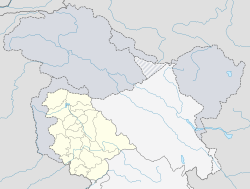Sông băng Siachen
| Loại | Mountain glacier |
|---|---|
| Tọa độ | 35°25′16″B 77°06′34″Đ / 35,421226°B 77,10954°Đ |
| Dài | 70 km (43 mi) |
Sông băng Siachen hay sông băng Tích Á Cầm nằm ở phía đông dãy Karakoram thuộc dãy núi Himalaya tại tọa độ 35°25′16″B 77°06′34″Đ / 35,421226°B 77,10954°Đ, ngay phía đông bắc của điểm NJ9842 nơi Line of Control giữa Ấn Độ và Pakistan kết thúc.[4] Với 70 km chiều dài, đây là sông băng dài nhất ở Karakoram và dài thứ 2 trên thế giới không tính khu vực vùng cực.[5] Đầu nguồn sông này ở độ cao 5.753m so với mực nước trên đèo Indira thuộc biên giới Trung Quốc và điểm cuối sông băng ở độ cao 3.620m.
Tham khảo
[sửa | sửa mã nguồn]- ^ See http://www.bharat-rakshak.com/MONITOR/ISSUE6-1/Siachen.html Lưu trữ 2012-06-14 tại Wayback Machine for perhaps the most detailed treatment of the geography of the conflict, including its early days, and under section "3." the current status of Indian control of Gyong La, contrary to the oft-copied misstatement in the old error-plagued summary at http://www.globalsecurity.org/military/world/war/siachen.htm
- ^ "India has been able to hold on to the tactical advantage of the high ground… Most of India's many outposts are west of the Siachen Glacier along the Saltoro Ridge." Bearak, Barry (ngày 23 tháng 5 năm 1999). “THE COLDEST WAR; Frozen in Fury on the Roof of the World”. The New York Times. Truy cập ngày 20 tháng 2 năm 2009.
- ^ In an academic study with detailed maps and satellite images, co-authored by brigadiers from both the Pakistani and Indian military, pages 16 and 27: "Since 1984, the Indian army has been in physical possession of most of the heights on the Saltoro Range west of the Siachen Glacier, while the Pakistan army has held posts at lower elevations of western slopes of the spurs emanating from the Saltoro ridgeline. The Indian army has secured its position on the ridge-line". Asad Hakeem & Gurmeet Kanwal, Michael Vannoni, Gaurav Rajen (ngày 1 tháng 9 năm 2007). “Demilitarization of the Siachen Conflict Zone” (PDF). Sandia Report. Sandia National Laboratories, Albuquerque, NM, USA. Bản gốc (PDF) lưu trữ ngày 17 tháng 4 năm 2012. Truy cập ngày 20 tháng 2 năm 2009.Quản lý CS1: sử dụng tham số tác giả (liên kết)
- ^ Lyon, Peter. Conflict Between India and Pakistan: An Encyclopedia. ABC-CLIO, 2008. ISBN 9781576077122.
- ^ Siachen Glacier is 70 km (43 mi) long; Tajikistan's Fedchenko Glacier is 77 km (48 mi) long. The second longest in the Karakoram Mountains is the Biafo Glacier at 63 km (39 mi). Measurements are from recent imagery, supplemented with Russian 1:200,000 scale topographic mapping as well as the 1990 "Orographic Sketch Map: Karakoram: Sheet 2", Swiss Foundation for Alpine Research, Zurich.
Chúng tôi bán
![[Tập hiểu sâu]: Vì sao Bạn luôn KHÔNG ỔN?](https://images.spiderum.com/sp-images/f5ab2630336211eea9e7ef608f381f46.png) GIẢM
12%
GIẢM
12%
200.640 ₫
228.000 ₫
 GIẢM
30%
GIẢM
30%
28.000 ₫
40.000 ₫
 GIẢM
48%
GIẢM
48%
180.000 ₫
343.000 ₫
 GIẢM
23%
GIẢM
23%
134.750 ₫
175.000 ₫






